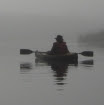
She wrote it from the perspective of a retiring seed grower, which means it can give the impression of a technical manual for a very narrow audience, but don't be fooled. I say, if you live in my ecoregion, you need to see this book.
Even if you will never grow anything, you might want to get acquainted with these plants. Consider this: they're your neighbours. They were here before you were, and likely will be long after. They might all look like "just grass" to you, but once you take a closer look, you may be astounded at the diversity in a tiny patch of unbroken prairie.
But here's the tricky part. Have you ever looked at a grassland in early June or late August and tried to find pictures in a field guide to match what you are seeing on the ground? Good luck. If you or anyone you know wants to learn to recognize some of the most common grasses and wildflowers of the mixed-grass prairies in the northern plains of North America, I say: start with this book. There are excellent photographs of multiple life stages of each plant, so you stand a good chance of recognizing your leafy new friend throughout the growing season - even when it's not so leafy. You won't have to wade through pages of obscure plants that you will never see, because there are only 62 wildflowers and 22 grasses included - only the most common species plus a few uniquely interesting species like buffalograss (rare in our region but common farther south in the short-grass prairie). As you learn the plants, you can also learn to recognize similarities among species in the same plant family, since the book is organized by families and includes identifying characteristics for each. That way, when you meet a plant that isn't introduced in the book, you may well be able to say, "You look familiar - aren't you related to..." and all of a sudden you will have a nodding acquaintance with hundreds of species.
And of course, if you want to actually grow these plants, whether as a seed business or just as a minimal-input alternative to a thirsty hungry lawn, you could benefit from the tips on planning and preparing a site, the illustrations to show you how your plants will look (even as seedlings so you can tell what not to weed out of your plot), the germination information, and tips and pictures to help you collect your own seed to get started.
I used to do inventories of the plant life on proposed oil and gas well sites. I worked with numerous floras and field guides, and through struggle and persistence, reached a point where I can look at most common prairie plants and just know them, no matter how small or shrivelled. But when I first started, and even in recent years when I was working very early in the growing season, I wish I had had this book.
Oh and did I mention that it's beautiful? People here were buying copies as Mother's Day gifts, just for the pictures of the their mothers' favourite flowers.
Yes, I'm proud of my Mom.





No comments:
Post a Comment